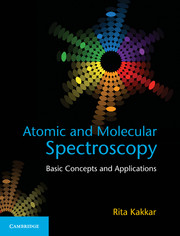Book contents
- Frontmatter
- Dedication
- Contents
- List of Figures
- List of Tables
- Preface
- Acknowledgements
- List of Abbreviations
- 1 Fundamentals of Spectroscopy
- 2 Theoretical Principles
- 3 Atomic Spectroscopy
- 4 Pure Rotational Spectroscopy
- 5 Vibrational Spectroscopy of Diatomics
- 6 Vibrational Spectroscopy of Polyatomic Molecules
- 7 The Raman Effect
- 8 Electronic Spectroscopy of Diatomic Molecules
- 9 Electronic Spectroscopy of Polyatomic Molecules
- Appendix 1 THE SPECTRUM OF THE NON-RIGID ROTATOR
- Appendix 2 CHARACTER TABLES OF SOME IMPORTANT SYMMETRY GROUPS
- References
- Index
1 - Fundamentals of Spectroscopy
Published online by Cambridge University Press: 05 June 2015
- Frontmatter
- Dedication
- Contents
- List of Figures
- List of Tables
- Preface
- Acknowledgements
- List of Abbreviations
- 1 Fundamentals of Spectroscopy
- 2 Theoretical Principles
- 3 Atomic Spectroscopy
- 4 Pure Rotational Spectroscopy
- 5 Vibrational Spectroscopy of Diatomics
- 6 Vibrational Spectroscopy of Polyatomic Molecules
- 7 The Raman Effect
- 8 Electronic Spectroscopy of Diatomic Molecules
- 9 Electronic Spectroscopy of Polyatomic Molecules
- Appendix 1 THE SPECTRUM OF THE NON-RIGID ROTATOR
- Appendix 2 CHARACTER TABLES OF SOME IMPORTANT SYMMETRY GROUPS
- References
- Index
Summary
La lumie‵re (…) donne
la couleur et l'e′clat a ‵toutes
les productions de la
nature et de l'art; elle
multiplie l'univers en le
peignant dans les yeux de
tout ce qui respire.
Light (…) gives colour and
brilliance to all works of
nature and of art; it
multiplies the universe by
painting it in the eyes of all
that breathe.
Abbe′Nollet, 1783INTRODUCTION
“Science is spectral analysis. Art is light synthesis”, so wrote Karl Kraus, Austrian writer. Light has intrigued both poets and scientists. What exactly is light? What effect does it have on matter? These are questions that have baffled scientists for many years, prompting Einstein in 1917 to say “For the rest of my life I will reflect on what light is”. The branch of science that deals with the study of electromagnetic radiation (of which visible light is a part) and its interaction with matter is called spectroscopy. The word is derived from the Latin: spectron – spectre (ghost or spirit), or the Greek: σκοπειν – to see. This literally means that in spectroscopy, you do not look directly at the molecule – the matter – but what you see is its ‘ghost’ or image. To begin our study, we must, therefore, first discuss the nature of electromagnetic radiation and matter, and then the interaction between the two.
We start this chapter by giving basic formulae and definitions relating to waves, including travelling waves. We then go on to the wave description of electromagnetic radiation and its manifestations, and then discuss the properties emerging from a particulate description of radiation. The entire electromagnetic spectrum, its divisions and sub-divisions, the kind of spectroscopy observed in each region, are the topics of the next section. The populations of energy levels play an important role in the observed intensities. Einstein's coefficients and their interrelation are introduced in this chapter, but the quantum mechanical treatment is reserved for the next chapter. We wind up this chapter with a discussion of line shapes and broadening, followed by a brief introduction to Fourier transform spectroscopy, the almost magical transformation of a time decay to a line width, and the experimental recording of spectra.
- Type
- Chapter
- Information
- Atomic and Molecular SpectroscopyBasic Concepts and Applications, pp. 1 - 50Publisher: Cambridge University PressPrint publication year: 2015



